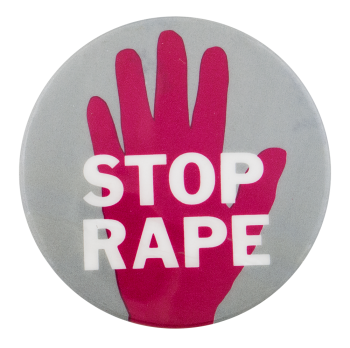| Category | |
|---|---|
| Additional Images | |
| Sub Categories | |
| Text on Button | STOP RAPE |
| Image Description | Illustration of a pinkish red hand with white text over it on a grey background |
| Curl Text | copyright 1983 DONNELLY/COLT BUTTONS BOX 188 HAMPTON CT 06247 |
| Back Style | |
| The Shape | |
| The Size | |
| Year / Decade Made | |
| The Manufacturer | |
| Additional Information | For most of the nineteenth and twentieth centuries, "rape" was understood to be a crime carried out by men unable to control their sexual desires. The anti-rape movement in the United States did not begin until the mid 1950s and 1960s when the rise of second-wave feminism redefined the act as a violent reaffirmation of the power dynamics present between men and women with rape committed primarily by men against women. The movement gained popularity throughout the 1970s, and by 1980s, the majority of US states had changed their laws to protect victims against invasive examination during trial, eliminate spousal exceptions, and eliminate requirements from the definition of the act, such as degree of physical trauma and physical resistance on the part of the victim. Since the 1980s, the anti-rape movement has continued to address the socio-cultural dynamics that perpetuate rape culture, most notably with the Me Too movement in 2017 that brought to light allegations of sexual harassment or assault by prominent men in the film and music industries, as well as in academia, sports, medicine, and politics. |
| Sources |
Matthews, N.A. (1994). Confronting rape: The feminist anti-rape movement and the state. London: Routledge. Rose, V.M. (1977). "Rape as a social problem: a byproduct of the feminist movement". Social Problems. 25 (1): 75–89. |
| Catalog ID | CA0316 |


